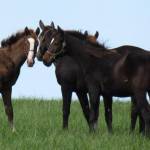Protein-to-Energy Ratio in Young-Horse Diets

Young horses need high-quality protein to supply adequate lysine and other amino acids for growth. In addition to protein, the young growing horse has a requirement for energy in its diet. These requirements are closely linked and a deficiency of either will result in a reduced growth rate. In fact, protein and energy are so closely linked that one should not be considered without the other in rations for growing horses.
In other words, it is the ratio of protein to energy that is important for growth rather than either the protein percentage in a ration or even the daily intake of protein, because it is the energy that provides the potential to grow new tissue that will then require protein. If there is an excess of protein supplied with an inadequate amount of energy, the protein will be oxidized to produce energy. This is a very expensive way to supply energy, however, and it should be avoided whenever possible. Therefore, knowing the ideal protein-to-energy ratio will greatly increase the precision with which a horse ration can be balanced.
Weanling, yearling, long yearling, and two-year-old horses have specific requirements for protein, and especially lysine, that are higher than those for mature horses. The protein-to-energy ratio and lysine-to-energy ratio are only indirectly related to growth rate. It is the total energy intake that will influence how fast the young horse will grow. A proposed equation for calculating the digestible energy (DE) requirements of yearling horses incorporates a maintenance energy requirement and takes the form: DE (Mcal/day) = 1.4 + 0.03 (BW kg) + 16 (average daily gain (ADG) in kg). According to this equation, a 340 kg (748 lb) yearling would require 11.6 Mcal DE plus an additional 16 Mcal DE for each kg of body weight gained per day. An average Thoroughbred yearling would gain about 0.5 kg (1.1 lb) BW/day and would therefore require 11.6 + 8 = 19.6 Mcal DE per day. Similar equations can be developed for other ages by taking into account the efficiency of utilization of DE for gain by each age group. Energy requirements for weanlings can be calculated as: DE (Mcal/day) = 1.4 + 0.03 (BW kg) + 10 (ADG kg); and for long yearlings: DE (Mcal/day) = 1.4 + 0.03 (BW kg) + 20 (ADG kg). A ration for yearlings might consist of 50% timothy hay and 50% grain mix. Since the protein-to-energy ratio of timothy equals 42.7 g CP/Mcal DE, the grain mix must contain 47.3 g CP/Mcal DE in order to average 45 CP/Mcal DE. Also, the grain must provide 1.93 g lysine/Mcal DE. A mix of 92% oats and 8% soybean meal will provide 47.3 g CP/Mcal DE and 1.97 g lysine/Mcal DE. Of course, this mix would also have to be balanced with the proper amount of minerals and vitamins, but it would provide the proper balance of protein and energy. The ration would contain 2.39 Mcal DE/kg and a yearling would therefore have to eat 8.2 kg (18 lb) per day in order to gain at a rate of 0.5 kg/day (1.1 lb/day).
This method of formulation is superior to using a table listing the protein percentage required by each age group. Basing calculations of the protein requirement of young growing animals on the protein percentage in the diet assumes that the energy concentration of the total diet is constant, though this is not always correct. Rations that are based largely on roughage have much lower energy densities and would require a lower concentration of protein. At the other end of the spectrum are the high-fat diets that are becoming more and more popular as diets for young growing horses. These diets have much higher energy densities than common horse rations, and would therefore require a greater protein percentage to obtain similar protein-to-energy ratios.
It has already been stated that if a diet has a higher than optimal protein-to-energy ratio, the extra protein will be broken down and used as an inefficient and expensive source of energy. But what happens if the diet has too low a protein-to-energy ratio? This type of ration will also be used inefficiently by the growing horse and result in a reduced feed-to-gain ratio.
If the protein-to-energy ratio is a great deal lower than optimal, the young horse will drastically decrease its feed intake and will fail to grow. Often when veterinarians are faced with a case of epiphysitis or some other metabolic bone disease in young growing horses, they recommend that the foals be placed on a total hay diet or grass hay plus a 10% protein grain mix. The intention is to slow down growth rate which often will help the problem. However, this type of approach is probably not the best one to use. It would be preferable to feed less of a feed with a proper protein-to-energy ratio which has been balanced with the correct amounts of vitamins and minerals for a foal of that age.








